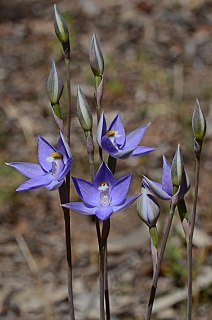
Thelymitra alcockiae, commonly called Kath's sun orchid, is a species of orchid that is endemic to southern continental Australia. It has a single long, narrow leaf and up to twelve pale blue to deep purplish blue flowers, mauve or reddish on their back side.
Thelymitra frenchii, commonly called the scarp sun orchid or Jarrahdale sun orchid, is a species of orchid in the family Orchidaceae and endemic to a small area in the south-west of Western Australia. It has a single long, fleshy leaf and up to three relatively small, blue flowers.
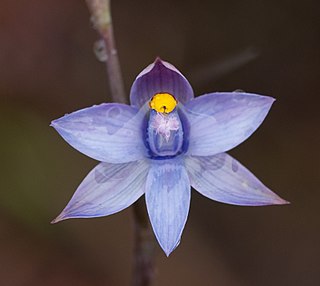
Thelymitra malvina, commonly called the mauve-tufted sun orchid, is a species of orchid that is native to eastern Australia and New Zealand. It has a single large, fleshy leaf and up to twenty five blue to mauve flowers with pink or mauve tufts on top of the anther.
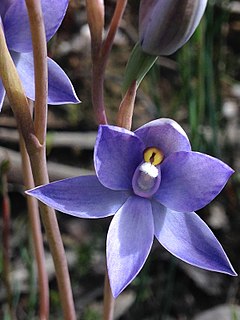
Thelymitra megacalyptra, commonly called the plains sun orchid, is a species of orchid that is endemic to eastern Australia. It has a single erect, fleshy leaf and up to fifteen blue to purplish, sometimes lilac, pink or white flowers with white tufts on top of the anther. It is known as Thelymitra megcalyptra by some authorities.
Thelymitra exigua, commonly called the short sun orchid, is a species of orchid that is endemic to south-eastern Australia. It has a single fleshy, channelled, dark green leaf and up to eight relatively small pale blue flowers with white toothbrush-like tufts on top of the anther.

Thelymitra graminea, commonly called the shy sun orchid, is a species of orchid in the family Orchidaceae and is endemic to the south-west of Western Australia. It has a single leathery, channelled leaf and up to ten relatively small blue, self-pollinating flowers with white, toothbrush-like tufts on the top of the anther.

Thelymitra granitora, commonly called the coastal granite sun orchid or coastal sun orchid, is a species of orchid in the family Orchidaceae and is endemic to the south-west of Western Australia. It has a single short, curved and channelled dark green leaf and up to eight relatively large pale blue or white, self-pollinating flowers with white mop-like tufts on the top of the anther.

Thelymitra holmesii, commonly called the blue star sun orchid, is a species of orchid that is endemic to south-eastern Australia. It has a single long, narrow, fleshy leaf and up to nine purplish blue to mauve flowers with a deeply notched lobe on top of the anther.
Thelymitra vulgaris, commonly called the slender sun orchid or common sun orchid, is a species of orchid in the family Orchidaceae and endemic to the south-west of Western Australia. It has a single erect, dark green leaf and up to nine relatively small, blue to purplish or white flowers.
Thelymitra xanthotricha, commonly called the yellow tufted sun orchid or yellow tufted slender sun orchid, is a species of orchid in the family Orchidaceae and endemic to the south-west of Western Australia. It has a single erect, fleshy, channelled, dark green leaf and up to six relatively large dark blue to purplish flowers.

Thelymitra mucida, commonly called the plum sun orchid or plum orchid, is a species of orchid that is endemic to southern Australia. It has a single erect, fleshy, linear leaf and up to six blue, purplish or plum coloured flowers with a thick, sticky secretion on the anther lobe.

Thelymitra canaliculata, commonly called the flushed sun orchid or blue sun orchid is a species of orchid in the family Orchidaceae and is endemic to the south-west of Western Australia. It has a single erect, fleshy leaf and up to twenty eight blue flowers with darker veins and sometimes flushed with pink. The lobe on top of the anther is blackish with a yellow crest.
Thelymitra latiloba, commonly called the wandoo sun orchid or wandoo shirt orchid, is a species of orchid in the family Orchidaceae and endemic to the south-west of Western Australia. It has a single erect, fleshy, channelled, dark green leaf and up to twelve blue flowers with darker blue veins and sometimes flushed with mauve. The lobe on top of the anther is wavy.
Thelymitra occidentalis, commonly called the western azure sun orchid or rimmed orchid, is a species of orchid in the family Orchidaceae and is endemic to the south-west of Australia. It has a single erect, fleshy, channelled, dark green leaf and up to fifteen blue flowers with darker blue veins and sometimes flushed with pink. The lobe on top of the anther has a wavy, yellow crest.

Thelymitra benthamiana, commonly called the leopard sun orchid or blotched sun orchid, is a species of orchid in the family Orchidaceae and is endemic to Australia. It has a single leathery leaf and up to ten yellowish green flowers with brownish spots, blotches and patterns. The column is yellow with deeply fringed wings and the lobe on top of the anther has a large lump on its top.

Thelymitra maculata, commonly called the spotted curly locks or eastern curly locks, is a species of orchid in the family Orchidaceae and endemic to the south-west of Western Australia. It has a single erect leaf, spiralling around the flowering stem and a single pink or purplish, spotted flower with more or less circular, yellow ear-like arms on the sides of the column.
Thelymitra uliginosa, commonly called southern curly locks or swamp curly locks, is a species of orchid in the family Orchidaceae and endemic to the south-west of Western Australia. It has a single erect leaf, spiralling around the flowering stem and a single small pink, mauve, blue or purplish flower with darker veins and sometimes darker blotches. There are two narrow, yellow arms on the sides of the column.
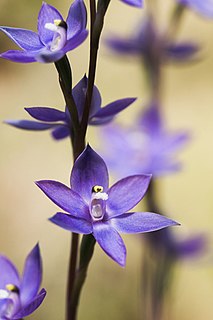
Thelymitra alpina, commonly known as the mountain sun orchid, is a species of orchid that is endemic to south-eastern Australia. It has a single dark green leaf with a purplish base and up to twenty, usually blue to purplish flowers. It grows in alpine, subalpine and montane areas of New South Wales, the Australian Capital Territory and Victoria.
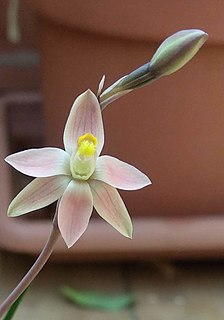
Thelymitra glaucophylla is a species of orchid that is endemic to South Australia. It has a single erect, channelled, pale green leaf and up to fifteen pale blue, mauve or white flowers with an inflated, greyish lobe on top of the anther.
Thelymitra paludosa, commonly known as the plain sun orchid, is a species of orchid that is endemic to Western Australia. It has a single erect, channelled, dark green leaf and up to ten or more blue to violet flowers. It grows in higher rainfall areas near the south coast.












